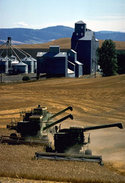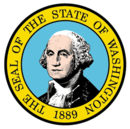Washington
|
|
| |||||
| State nickname: The Evergreen State | |||||
| Missing image Map_of_USA_highlighting_Washington.png Map of the U.S. with Washington highlighted | |||||
| Other U.S. States | |||||
| Capital | Olympia | ||||
| Largest city | Seattle | ||||
| Governor | Christine Gregoire | ||||
| Official languages | None | ||||
| Area | 184,824 km² (18th) | ||||
| - Land | 172,587 km² | ||||
| - Water | 12,237 km² (6.6%) | ||||
| Population (2000) | |||||
| - Population | 5,894,121 (15th) | ||||
| - Density | 34.20 /km² (25th) | ||||
| Admission into Union | |||||
| - Date | November 11, 1889 | ||||
| - Order | 42nd | ||||
| Time zone | Pacific: UTC-8/-7 | ||||
| Latitude | 45?32' N to 49? N | ||||
| Longitude | 116?57' W to 124?48' W | ||||
| Width | 385 km | ||||
| Length | 580 km | ||||
| Elevation | |||||
| - Highest | 4,392 m | ||||
| - Mean | 520 m | ||||
| - Lowest | 0 m | ||||
| Abbreviations | |||||
| - USPS | WA | ||||
| - ISO 3166-2 | US-WA | ||||
| Web site | access.wa.gov | ||||
Washington is a state in the Pacific Northwest of the United States. The state capital is Olympia and the largest city in Washington is Seattle. As of the 2000 census, the state population was approximately 5.9 million and the state work force numbered about 3.1 million. Residents are called "Washingtonians" (emphasis on the third syllable, which rhymes with bone).
It should not be confused with Washington, D.C., the nation's capital. To avoid confusion, the capital is often called simply D.C., and the state often called Washington State.
Washington is the only state named after a president, which was George Washington.
The battleship USS Washington was named originally for President Washington, but was later renamed in honor of the state.
| Contents |
History
Prior to the arrival of explorers from Europe, this region of the Pacific Coast had many established tribes of Native Americans, each with its own unique culture. Today, they are most notable for their totem poles and their ornately carved canoes and masks. Prominent among their industries were salmon fishing and whale hunting. In the east, nomadic tribes travelled the land and missionaries such as the Whitmans settled there.
The first European record of a landing on the Washington coast was by Spanish Captain Don Bruno de Heceta in 1775 on board the Santiago, part of a two-ship flotilla with the Sonora. They claimed all the coastal lands up to the Russian possessions in the north for Spain.
In 1778, British explorer Captain James Cook sighted Cape Flattery, at the entrance to the Strait of Juan de Fuca, but the straits would not be explored until 1789 by Captain Charles W. Barkley. Further explorations of the straits were performed by Spanish explorers Manuel Quimper in 1790 and Francisco Eliza in 1791, then by British Captain George Vancouver in 1792.
The Spanish Nootka Concession of 1790 opened the northwest territory to explorers and trappers from other nations, most notably Britain and then the United States. Captain Robert Gray (for whom Grays Harbor county is named) then discovered the mouth of the Columbia river and, beginning in 1792, he established trade in Sea Otter pelts. In 1805 the Lewis and Clark expedition entered the state on October 10.
In 1819 Spain ceded their original claims to this territory to the United States. This began a period of disputed joint-occupancy by Britain and the U.S. that lasted until June 15, 1846 when Britain ceded their claims to this land with the Treaty of Oregon.
Due to the migration along the Oregon Trail, many settlers wandered north to what is now Washington State and settled the Puget Sound area. The first settlement was New Market (now known as Tumwater) in 1846. In 1853 the Northern Pacific railroad line reached Puget Sound, linking the region to the other states. During that same year Washington Territory was formed from part of Oregon Territory.
Washington became the 42nd state in the United States on November 11, 1889.
Early prominent industries in the state included agriculture and lumber. In eastern Washington the Yakima Valley became known for its apple orchards while the growth of wheat using dry-farming techniques became particularly productive. The heavy rainfall to the west of the Cascade Range produced dense forests and the ports along Puget Sound prospered from the manufacturing and shipping of lumber products, particularly the Douglas fir. Other industries that developed in the state include fishing, salmon canning and mining.
By the turn of the 20th century the state of Washington was one of dangerous repute in the minds of many Americans. Undisputably as "wild" as the rest of the wild west, the public image of Washington merely replaced cowboys with lumberjacks, and desert with forestland.
For a long period Tacoma was noted for its large smelters where gold, silver, copper and lead ores were treated. Seattle was the primary port for trade with Alaska and the rest of the country and for a time possessed a large ship-building industry. The region around eastern Puget Sound developed heavy industry during the period including World War I and World War II and the Boeing company became an established icon in the area.
During the depression era a series of hydroelectric dams were constructed along the Columbia river as part of a project to increase the production of electricity. This culminated in 1941 with the completion of the Grand Coulee Dam, the largest in the United States.
During World War II the Puget Sound area became a focus for war industries with the Boeing Company producing many of the nation's heavy bombers and ports in Seattle, Bremerton and Tacoma available for the manufacturing of ships for the war effort. In eastern Washington the Hanford Works atomic energy plant was opened in 1943 and played a major role in the construction of the nation's atomic bombs.
In 1980, following a period of heavy tremors and eruptions, the northeast face of Mount St. Helens exploded outward, destroying a large part of the top of the volcano. This eruption flattened the forests for many kilometers, killed 57 people, flooded the Columbia River and its tributaries with ash and mud and blanketed large parts of Washington in ash, making day look like night.
In 2004 Washington's gubernatorial race was so close that the Secretary of State certified Republican candidate Dino Rossi as governor-elect almost a month after the polls had closed, beating out the Democratic candidate Christine Gregoire by just over two hundred votes. Due to the small margin of victory, a machine recount (required by law) took place and, by a margin of only 42 votes out of more than 2.8 million cast, Rossi won again. However, the Democrats requested a final hand count of the votes. Gregoire ended up winning this count by 129 votes and was inauguarated on January 12, 2005. The election was contested by the Washington State Republican Party. (http://www.wsrp.org), however on June 5th, 2005, Chelan County Judge John Bridges ruled against the Republicans. Rossi stated he wouldn't contest, and the controversy ended.
Geography
OlympicCoastNationalMarineSanctuary.jpg
County_map_of_Washington_state.png
Washington is bounded by the Pacific Ocean to the west, Oregon to the south (the Columbia River forming most of this border), Idaho to the east and British Columbia, Canada to the north. It is famous for scenery of breathtaking beauty and sharp contrasts. High mountains rise above evergreen forests and sparkling coastal waters. Its coastal location and Puget Sound harbors give it a leading role in trade with Alaska, Canada, and the Pacific Rim. Puget Sound's many islands are served by one of the largest state ferry fleet in the world. Washington is a land of contrasts. The deep forests of the Olympic Peninsula are among the rainiest places in the world and the only rainforests in the continental United States, but the flat semi-desert that lies east of the Cascade Range stretches for long distances without a single tree. Snow-covered peaks tower above the foothills and lowlands around them. Mount Rainier, the highest mountain in the state, appears to "float" on the horizon southeast of Seattle and Tacoma on clear days. The eastern side of the state can be divided into two regions: the Okanogan Highlands and the Columbia River Basin.
Washington is also notable for being home to four of the five longest floating bridges in the world: the Evergreen Point Floating Bridge, Lacey V. Murrow Memorial Bridge and Homer M. Hadley Bridge over Lake Washington, and the Hood Canal Bridge connecting the Olympic and Kitsap Peninsulas.
See also Central Washington, Columbia River Plateau, Eastern Washington, Inland Empire, Kitsap Peninsula, Palouse, Western Washington.
Geographical features
The-dalles-dam-columbia-river-usa.jpg
Mount-rainier-over-tacoma.jpg
A fuller list of Washington state's islands appears here.
National-atlas-washington.png
Demographics
According to the U.S. Census Bureau, as of 2003, Washington's population was estimated at 6,131,445 people.
The racial makeup of the state is:
- 78.9% White
- 3.2% Black
- 7.5% Hispanic
- 5.5% Asian
- 1.6% American Indian
- 3.6% mixed race
The five largest ancestry groups in Washington are German (18.7%), English (12%), Irish (11.4%), Norwegian (6.2%) and Mexican (5.6%).
6.7% of Washington's population were reported as under 5, 25.7% under 18, and 11.2% were 65 or older. Females made up approximately 50.2% of the population.
Religion
The religious affiliations of the citizens of Washington are:
- Protestant ? 55%
- Roman Catholic ? 19%
- Other Christian ? 4%
- Other Religions ? 2%
- Non-Religious ? 15%
The three largest Protestant denominations in Washington: Lutheran (8% of the total state population), Baptist (7%), Methodist (6%).
Important cities and towns
Seattle_from_kerry_park.jpg
- Seattle
- Olympia
- Spokane
- Tacoma
- Bellevue
- Redmond
- Aberdeen
- Vancouver
- Everett
- Tri-Cities
- Walla Walla
- Wenatchee
- Yakima
- Bremerton
- Port Townsend
- Bellingham
See also List of cities in Washington State, List of towns in Washington State and Washington city government
Economy
The 2003 total gross state product for Washington was $244 billion, placing it 11th in the nation. The per capita income was $33,332. Significant business within the state include the design and manufacture of jet aircraft (Boeing), computer software development (Microsoft), electronics, biotechnology, aluminum production, lumber and wood products, mining, and tourism. The state has significant amounts of hydroelectric power generation. Significant amounts of trade with Asia pass through the ports of the Puget Sound.
Agriculture

Washington is a leading agricultural state. (The following figures are from the Washington State Office of Financial Management (http://www.ofm.wa.gov/databook/pdf/nt14.pdf) and the Washington Agricultural Statistics Service (http://www.nass.usda.gov/wa/ssoinfo.htm).)
For 2001, the total value of Washington's agricultural products was $5.4 billion, the 12th highest in the country. The total value of its crops was $3.2 billion, the 8th highest.
In 2002 Washington ranked first in the nation in production of raspberries (87.8% of total U.S. production), hops (74.4%), spearmint oil (also 74.4%), wrinkled seed peas (65.6%), apples (60.2%), Concord grapes (51.8%), sweet cherries (48%), pears (44.9%), lentils (41.9%), peppermint oil (35.2%), carrots for processing (34.5%), tart cherries (32.8%), Niagara grapes (32.4%) and sweet corn for processing (29.2%). Washington also ranked second in the nation in grapes (all varieties taken together), apricots, asparagus (over a third of the country's production) and green peas for processing; third in the nation for wheat, prunes and plums, summer dry onions, trout and butter; fourth in barley and peaches; and fifth in cranberries and strawberries.
Education
Colleges and universities
Community colleges
Professional sports teams
Arts and culture
Digital-elevation-map-washington.gif
State symbols
For Washington State symbols (like its state bird and state flower), see Washington State symbols.



